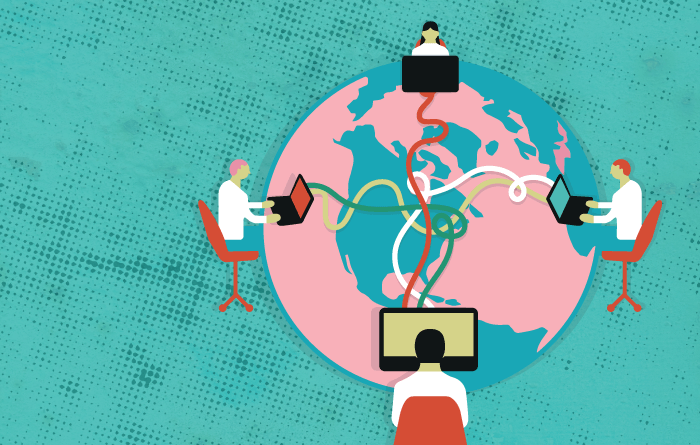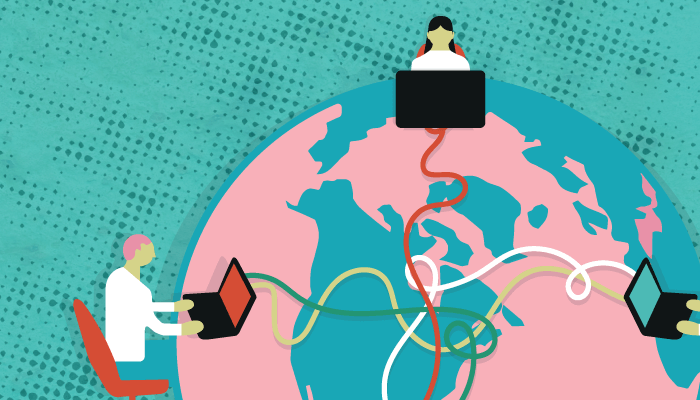
In 2016, Allergan launched the International Retina Panel: a mentorship program aimed at individuals who had shown excellence in clinical practice and research. For three years, we worked alongside other passionate clinicians analyzing clinical cases and presenting our findings at conferences worldwide. Those same clinicians became our colleagues and in time, our friends. 12 months into the program, we realized we weren’t ready to walk away from the network we had created. We decided to turn it into something else. A year later, we formed the International Retina Group (IRG): a collaborative network made up of 25 delegates from 14 countries – 12 retina surgeons and 13 medical retina specialists, with expertise in uveitis, imaging and epidemiology.
Our model is not completely unique – there are other collaborative networks in ophthalmology – but we are the only one (at least, the only one we know of) whose members don’t hail from the same country, and the only one that operates without private funding. This has its advantages and disadvantages. While we are an independent group and we want to stay independent, financial support gives you the freedom to pursue bigger projects. We hope to secure altruistic funding ourselves in the future. But at the end of the day, the focus is on improving patients’ lives, not our own careers. If we could offer advice to any researchers hoping to do something similar, let it be this: don’t just do research for research’s sake, do it for the purpose. Believe that what you are doing matters – and have a mentor.
During our time with Allergan, we were lucky to be mentored by Professor Jayakrishna Ambati and Professor Anat Loewenstein – who continued to act as our mentor after the program ended. Anat Lowenstein has been invaluable to the IRG. She has an excellent eye and every single correction, comment and suggestion she makes is taken on board. She offers productive feedback in as little as two or three days and has – we have no doubt – increased our chances of being published by lending her input. But it is more than that. A mentor can also teach you essential “soft” skills, such as how to manage conflict. We are grateful for her support.
The way we work is simple [see box Collaboration Model]. The main research author has an idea which they share with the rest of the group, who then decide if it is worth pursuing. The main author sends a protocol and people choose whether or not to contribute – not every member has to contribute the same way. Some cannot send patient data, but they can take part in other ways, by running the statistical analysis, helping to write the paper, or offering critical review, which is equally important. We usually set a deadline of a month for this part. Then comes the writing.
When we all work together, we typically write a paper in three or four days. The time goes by quickly when you enjoy what you do. Once the manuscript is written, the main author then sends the manuscript to everyone in the group. Once our comments have been collated, we send the final draft to Anat Loewenstein, who has the final say. If she makes a suggestion, we take it on board – we know her supervision is key to our success.
Idea
Group discussion
Email protocol
Send data
Run statistical Analysis
Write paper
Review
Send to journal
As you’d expect with such an international group (our members are spread from Australia to Argentina), productivity for us doesn’t happen between 7 am and 7 pm. Since we are all practicing physicians, we do most of our research after clinic, between 7 pm and 7 am. The exception to the rule is the weekly call we have every Saturday. We typically talk at 9 pm (for Dinah in Israel), 3 pm (for Matias in Argentina). On the whole, time zones are irrelevant. We just work when we have the time. It goes without saying that if you are going to commit to working on a project in your free time, you have to be passionate about it – otherwise it is not going to happen. We have found the best way to get a paper done is by enjoying the journey. It may take six or seven months before the paper is published.
If you don’t enjoy the process, it will take a lot longer and you will resent it, which is why we make a point of enjoying every meeting for what it is. We ask about each other’s families, how the children are, and then we get to work. Those meetings are used to discuss everything from statistical analysis to the best journal for each paper. It is very international, open and collaborative, and through making sure every opinion is valued, everyone is happy with the outcome. Of course, that does not necessarily mean we always all agree! Not everyone contributes every time, and that is okay. Sometimes people will say: “If you don’t take my revision, please leave me out of the paper,” and we respect their wishes. Ultimately, our network is based on friendship, and preserving that friendship is crucial. It's

People tend to assume that there must be competition in a group this large, but that is not the case. Allergan wisely chose delegates from all around the world – one or two per country – and in cases where there were more, for instance, three in Australia, they worked in very different places. And for good reason. No matter how well you get along, when you work in the same field, there will be times when you inevitably fight for the same positions. By working all over the world, we mitigate any conflict of interest. Regardless, we take the view that the group’s success is our individual success, too. If we want to truly be productive, we need to work together.
Another benefit of working with researchers from around the world is the diversity of our data – everyone brings a different patient population to an issue. For example, some of our members can choose Ozurdex (dexamethasone intravitreal implant) as a first line treatment, but others cannot, so that in itself allows us to study diverse patient populations undergoing a variety of local treatment regimens. Our papers cover a range of retina topics, from choroidal tumors to the impact of the dexamethasone implant on diabetic macular edema.
Over the last two years, we have published an average of one paper a month – more than any of us could have done alone. There is no big secret to making it work. You simply have to love what you do. If you don’t love the process – sharing data, speaking to other researchers – you won’t make it. Our network only works because of the people; each and every member of the group has a close relationship with everyone else. If you would like to do something similar, find people that you that you like and trust – and don’t be afraid to share data. People can be possessive – rightly or wrongly – but you have to think of the bigger picture: improving patients’ lives. The saying goes: “we are stronger together” and it is true! Take advantage of other people’s skills, and combine your advantages. Take the two of us for example: one of us is excellent at referencing, while the other loves English grammar. We are both very open for improvement, which is a bonus.
By writing these papers, we hope to answer the questions we ask ourselves as clinicians. The paper we are currently working on came about that way. Dinah noticed that there was some kind of scar or subretinal exudate on the macula of DME patients who had undergone vitrectomy as a first-line treatment. We were afraid this would lead to irreversible vision loss but instead of just saying “This is very bad,” we decided to follow up on those patients. We saw that the reflectivity would decrease over time so we hypothesized that this may be due to inflammation in diabetic eyes without the scaffold of the vitreous. Interestingly, when we imaged the same patients a few months later, the sign had disappeared. It was only by sharing our experiences that we were able to see that this wasn’t something to worry about.
Your own experiences are a great source of research inspiration. We made a WhatsApp group for IRG members so we could consult about difficult cases. What often starts as a “Hey, has anybody seen this before?” can lead to a new study. Ultimately, it is comforting to be able to share our findings with other physicians, so we can share them, in turn, with our patients.
There you have it: our blueprint for international collaboration. We hope it works as well for you as it has for us. Our thanks go to Allergan for getting us together for the first International Retina Panel meeting in 2016. We might have created the social and scientific network, but they gave us the tools – and we will continue to use them wisely. Good luck!
